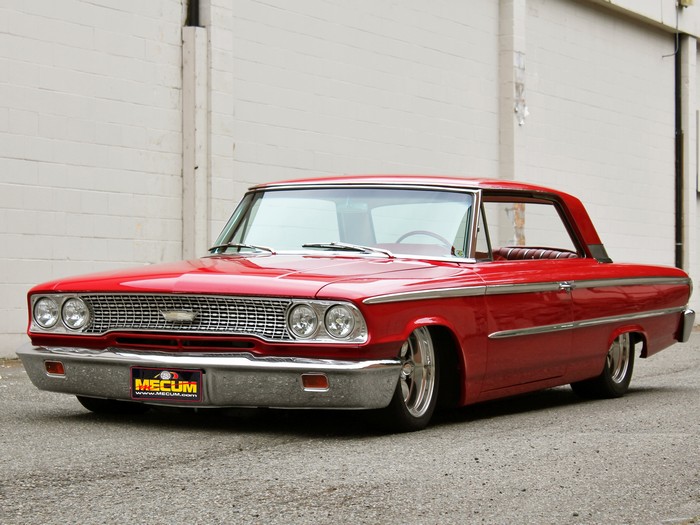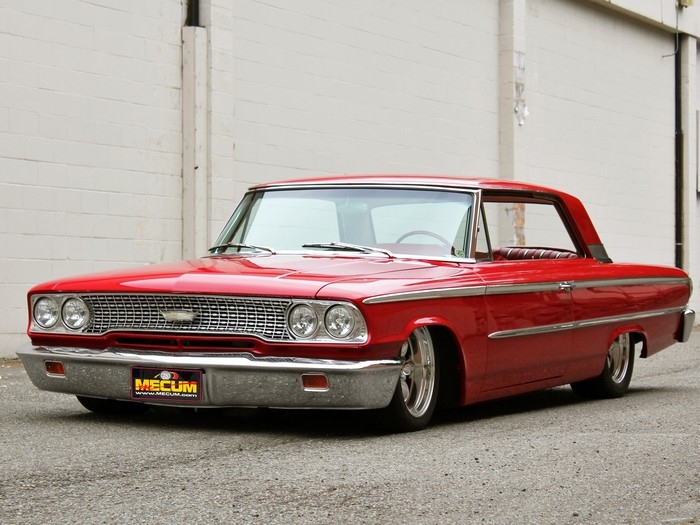
This ’63 Galaxie 500 XL is the product of a meticulously finished, show-quality frame-off restoration with an eye toward subdued customization and increased performance. It’s a multiple award and show winner, including Ford Muscle Pick at the Goodguys Northwest Nationals in 2011.
It was delivered from the factory in Rangoon Red over red interior with a 390-ci big block and 4-speed manual. Under the hood now lives a pro-built, stroked 428-ci Cobra Jet V8 that makes an estimated 650 hp.
SCM Analysis
Detailing
| Vehicle: | 1963 Ford Galaxie 500 XL Custom hard top |
| Years Produced: | 1959–74 |
| Number Produced: | 648,010 (all 1963 Galaxie models) |
| Original List Price: | $2,610–$3,625 |
| SCM Valuation: | $40k–$60k (this car) |
| Tune Up Cost: | $200 (as configured) |
| Distributor Caps: | $25 |
| Chassis Number Location: | On tab on right side of firewall under hood |
| Engine Number Location: | (390) Passenger side of block, behind starter (casting number only) |
| Website: | www.galaxieclub.com |
| Alternatives: | 1963 Chevrolet Impala, 1963 Ford Fairlane 500, 1963 Plymouth Sport Fury |
| Investment Grade: | C |
This car, Lot F216, sold for $60,950, including the buyer’s premium, at the Mecum Monterey sale in Monterey, CA, on August 16–18, 2012.
Let’s get this out of the way straight off: Although Ford Galaxies have a respectable following, they are, for the most part, $15,000–$25,000 cars on a good day. And that’s for a nice example fitted with a V8. Grandma’s column-shift, bench-seat grocery getter might only fetch $10,000 when it’s time to sell.
But that range doesn’t take into account some of the more desirable editions such as convertibles, Lightweights, and 406, 427 and 7-liter examples.
In 1963, Galaxie engine selections included a dizzying array of cubic inches. They ranged from a 223-ci six-cylinder through 292-ci, 260-ci, 289-ci, 352-ci, 390-ci, and 406-ci V8s. Lastly, the rare R-code 427 was also available, with a published 425 hp. And a fastback roofline (aka Sports Roof) was added mid-year to improve the styling and make the cars more competitive in the NASCAR circuit. So it didn’t really matter who you were — there was a Galaxie to fit your needs. And Ford sold 648,010 of them that year.
A customized “Boxtop”
Our subject car was born as a Rangoon Red “Boxtop” Galaxie 500 XL fitted with a 390 and rare 4-speed transmission.
The engine and trans combination make this car somewhat desirable, although both are now gone, and the body isn’t at the top of the hot list of collectible Fords the same way a 427-powered convertible would be. But the builder did fit a pro-built 428 Cobra Jet stroked to 465 ci and rated at 650 hp. The three-year restoration also included adding a Tremec 5-speed manual transmission, four-channel Air Ride suspension and a full array of classic custom gauges.
The car was also featured in Street Rodder magazine, which adds a modicum of provenance. Further, it was the recipient of the Goodguys Northwest Nationals Ford Muscle Pick in 2011, which means it’s a shoo-in to collect trophies at the local Saturday afternoon show-’n’-shine.
Burn your price guide
This car’s mild custom work makes it a one-off creation, so when it comes to putting a number on it, you might as well toss your price guides out the window.
It’s not that the build isn’t repeatable — it is — it’s just unique to this car and would be costly to duplicate. The stance is just right, the engine selection is superb, and that transmission will be great for cruising. The Air Ride gives both a smooth ride and control over the car’s ride height, and the large 17-inch American Racing wheels give the car a modern but uniquely vintage look. There are several other goodies on board as well, such as big 11-inch disc brakes, three-inch exhaust and power steering, all of which should make it sound, stop, and handle a lot better than stock.
So when you add it all up, this is one bad machine, with the only knocks being the notchback rear window and a lack of a retro air conditioning system. But $60k? Can’t you buy a lot more car for that same money?
What’s it worth?
Custom cars, depending on the build quality and how far from stock they’ve traveled, are subject to free market gravitation. Take the wrong car and build it to SEMA show standards, and you might as well have invested your money in Enron. But take the right car, with the right build, and you’ll have yourself a car with a broader market and more universal appeal. I’ve seen it up close and personal — the wrong cars with fresh six-figure builds that fail to see half that money on an auction block. Alternatively, build a car that is too radical and you might end up in the same place, even if it’s a widely popular car, such as a 1969 Camaro.
Did this builder invest the right money in the wrong car? Well, Galaxies aren’t as popular as Mustangs, but I think this car’s Monterey buyer voted with his wallet. And there were at least two bidders interested enough to push the car to this price level. Add in the Goodguys awards and magazine appearance and you’ve got pretty solid evidence of this car’s cool factor.
Dare to be different
Mustangs may be more popular than cars like this Galaxie, but they rarely raise eyebrows at local car shows. A lot of these Galaxies were built, but they don’t have a huge following. But this car is just different enough from the current norm to be well received at a car show while still being easy to work on thanks to a large parts supply. And therein lies the value, at least for some people.
It doesn’t take a math genius to figure out that it cost a whole pile of cash to get this car into this configuration and quality level — probably a figure far north of the selling price. The show-quality paint and brightwork could easily have broken $20,000 on their own.
If re-creating something like this would cost more than the buyer spent here, was it a good buy? Financially, it may be harder to sell than a similar $60k Mustang because there are fewer buyers in the market for Galaxies, and it’s important to note that every mile put on it along with every new stone chip will deteriorate the overall monetary value. So you could call it well sold at this price and be done with it.
But the “cool factor” is certainly worth something. That’s the head-turning component that makes people stop and look when they walk past. And this car had that in spades — it’s custom, it’s clean, and it’s cool. And most importantly, it’s different. So all things considered, I think we can call the price fair, as long as the investment is measured in smiles per mile rather than just the car’s future sales price, after a few sets of tires and a handful of years have passed.
For now, the new owner should have tons of fun terrorizing unsuspecting victims and wearing out his hand with overzealous high-fives at the Biff Burger. I hope he drives it, enjoys it, and always has a new microfiber towel to wipe off the drool. Well bought and sold.
(Introductory description courtesy of Mecum Auctions.)
